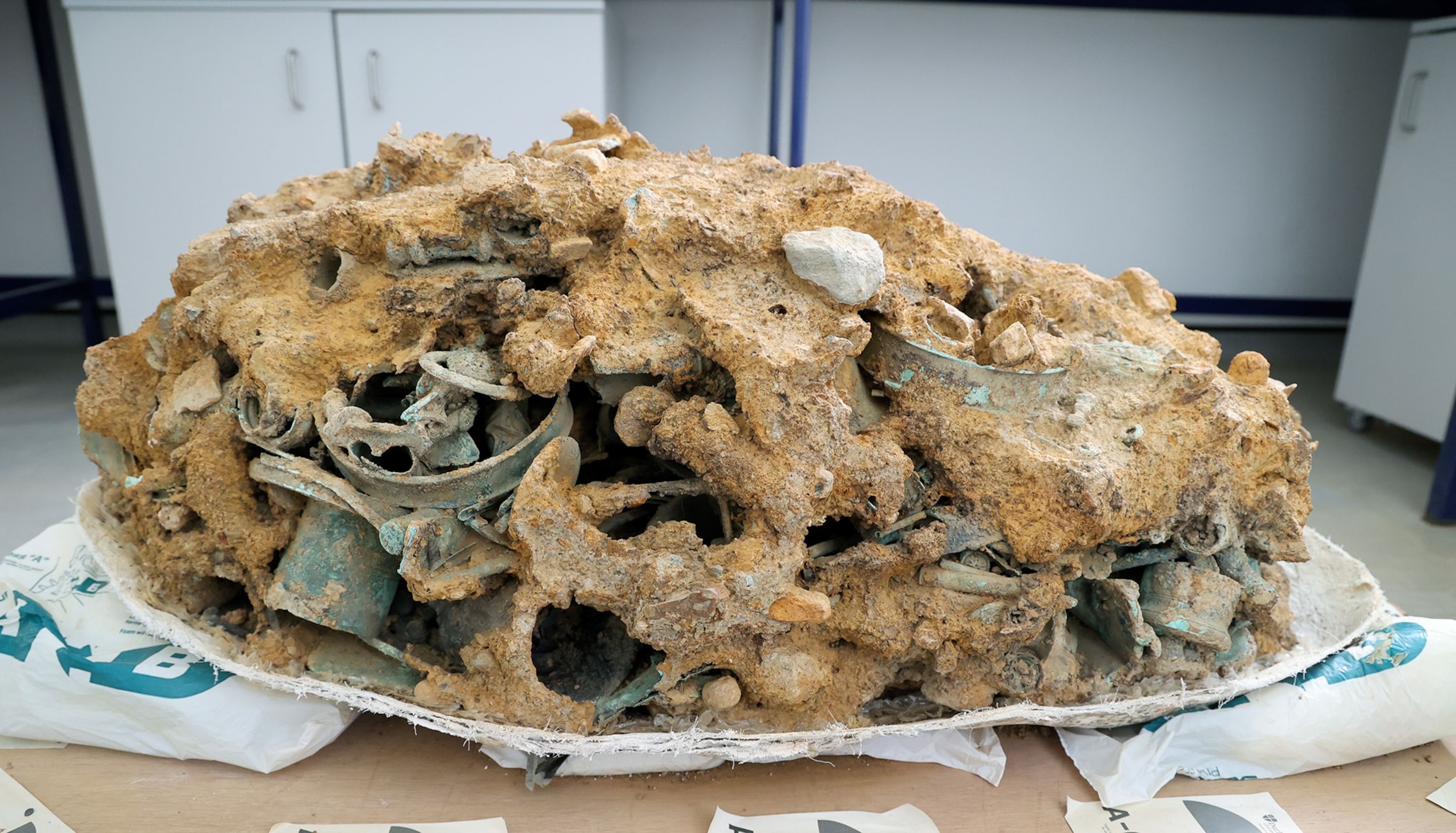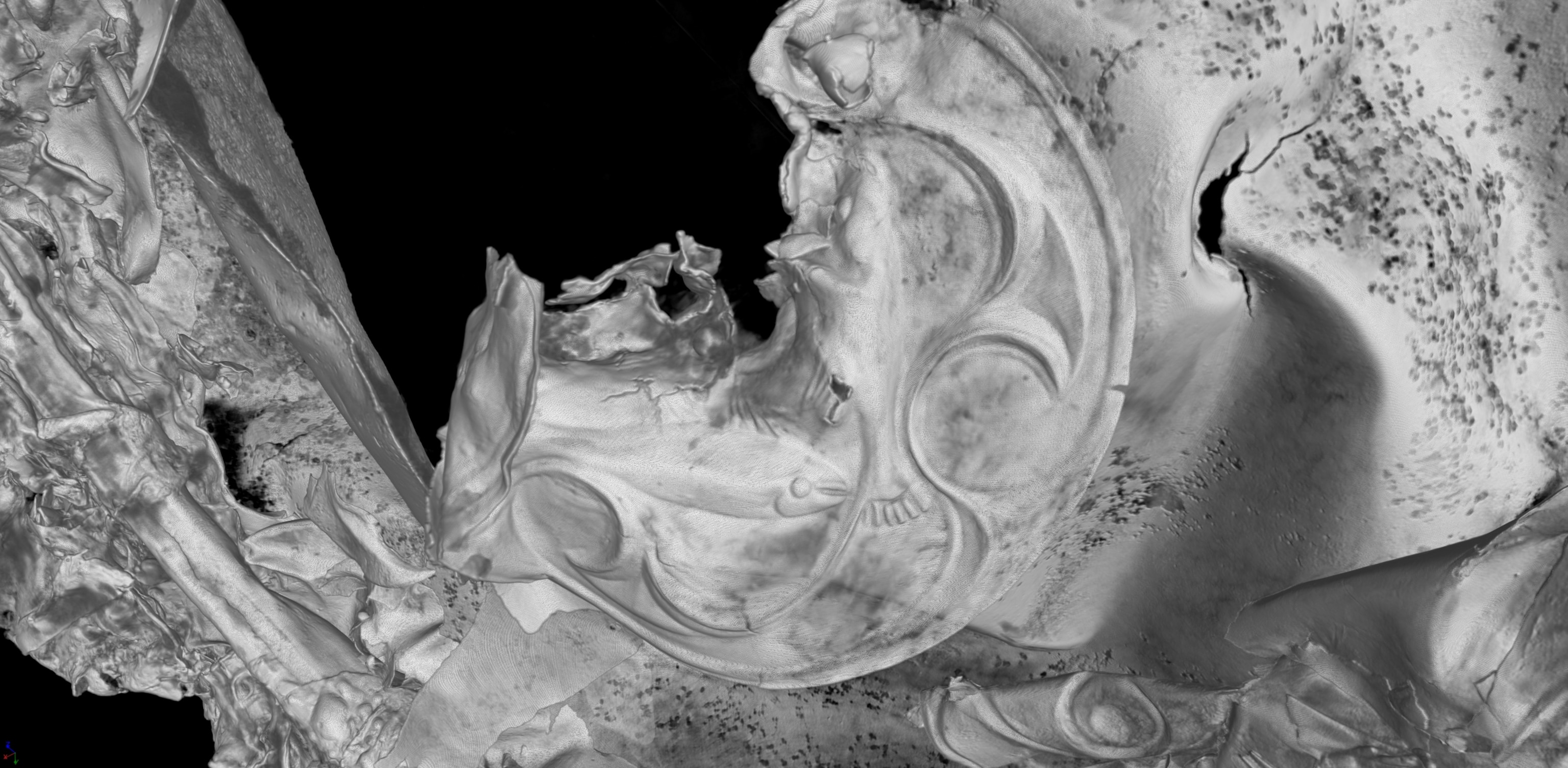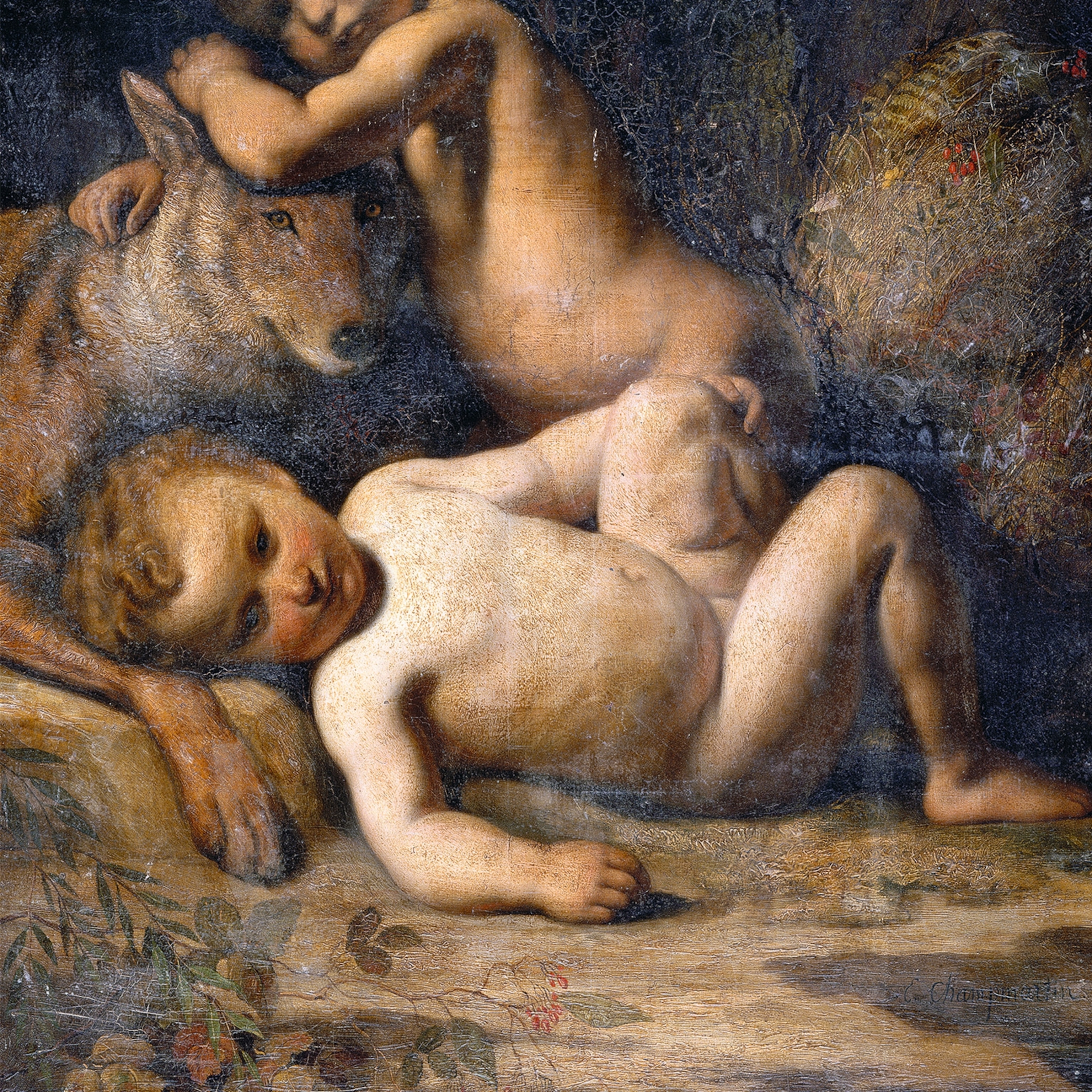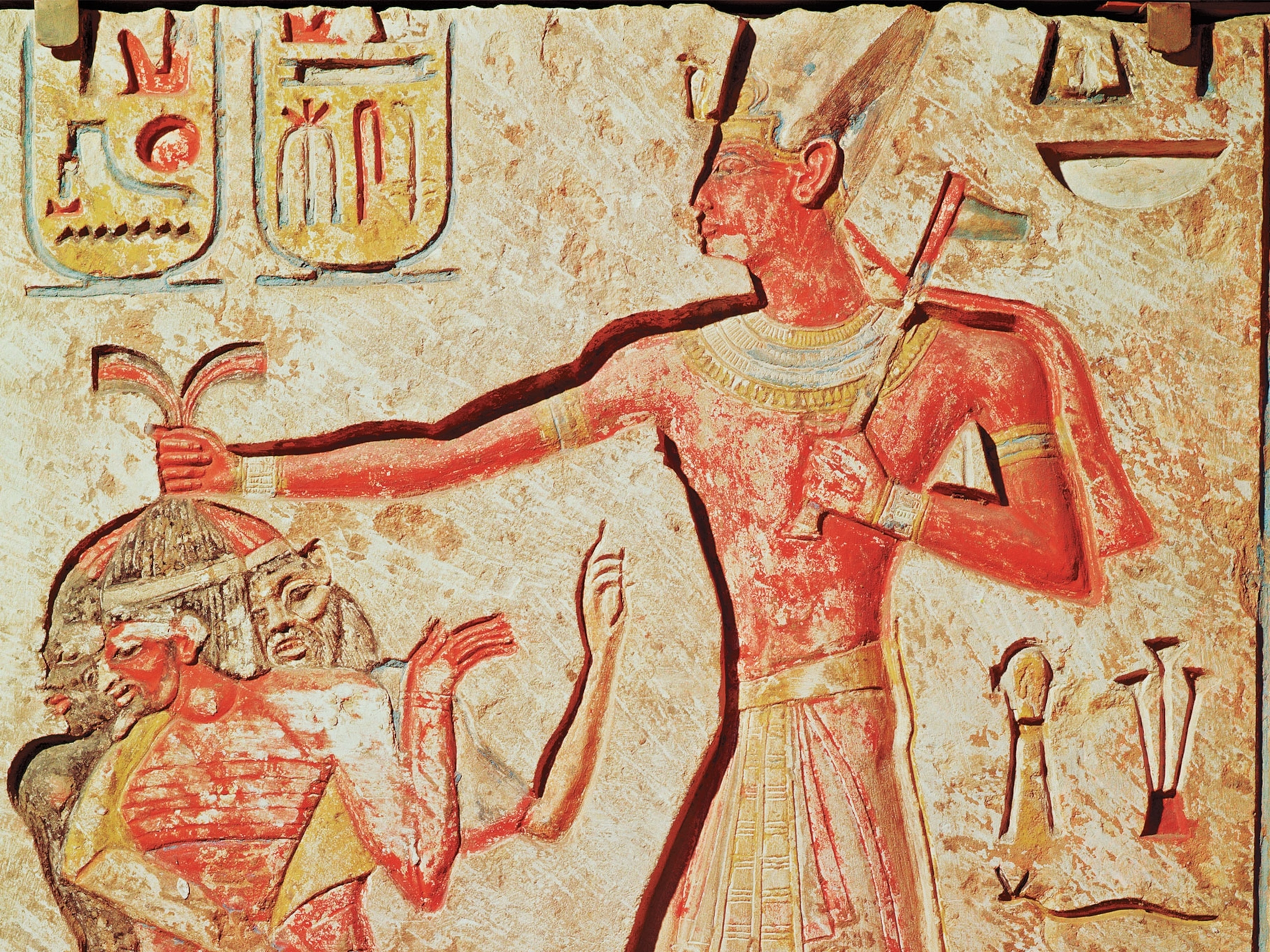What was Britain like before the Roman conquest? A new hoard of treasures gives us clues.
A cauldron, chariot parts, ornate jewelry: Precious objects found in the Melsonby Hoard are shedding new light into the rituals of Iron Age Britain.

Late in 2021, a man running a metal detector over the muddy fields of northern Britain got a hit. Rather than picking up a shovel and digging out his treasure, he decided to phone Tom Moore, an archaeologist who’s worked extensively on the local landscape. Moore and his team came to inspect the find and unearthed more than 900 objects, an enormous trove, that had been piled in a ditch in the waning days of the British Iron Age (ca 750 B.C. to A.D. 43), sometime around the time of the birth of Christ.
Pieces of horse harness, dozens of iron tires, hefty spears, a cauldron, parts of chariots or wagons, ornate jewelry, a large iron mirror, and what may be a wine mixing bowl were all deposited in what’s now Yorkshire—left there for mysterious reasons. The objects were luxurious for their era: craftsmanship of the highest order, representing untold hours of labor. But perhaps even more curious was that these valuable objects were deliberately wrecked before they were put into the ground. The iron tires were burned and twisted out of shape, and the cauldron was flattened. These treasures slept silently underground for two millennia.

Now known as the Melsonby Hoard, after the town where it was discovered, the find grants a rare peek into Britain in the Iron Age, a period of flux for the island, when the Romans expanded their reach across Europe and cast their eyes toward Britannia, a place they considered the ragged edge of the known world, populated by peoples with customs vastly different from their own. The ancient Britons were watching the Romans too, but we know precious little about what they were thinking, because they left us no written records of their own.
The hoard is already reshaping our understanding of the ancient Britons and the world they inhabited. Faded coral and corroded objects tell of deepening links between northern Britain and the Mediterranean; once jangling bits of horse harness and vehicle parts give a glimpse of the culture that predated Roman arrival by centuries, one that demands painstaking reconstruction by archaeologists, using finds like this one.
The mysterious tribes of Iron Age Britain
The first century B.C. was a period of enormous change in Britain. Centuries-old ways of living were shifting–fast. “We’re looking at really rapid social change,” with new settlement types, new burial types, and new eating patterns all emerging, says Rachel Pope, who studies Iron Age Europe at the University of Liverpool and was not involved with the excavation. One important factor in those changes: the Romans, who were pushing steadily northward across modern-day France under the leadership of Julius Caesar.
Before he was unceremoniously stabbed to death, Caesar oversaw military incursions into Britain in 55 and 54 B.C., seemingly in hopes of extending the Roman Empire. His disapproval of the people the Romans found across the Channel practically drips off his account: “Of the inlanders most do not sow corn, but live on milk and flesh and clothe themselves in skins. All the Britons, indeed, dye themselves with woad, which produces a blue color, and makes their appearance in battle more terrible.”
It took nearly a century more for Rome to mount a full-on invasion, which came under Emperor Claudius in A.D. 43. And even then, imperial control was far from absolute: Roman sources recount fierce resistance, such as the revolt of Queen Boudica, whom the Roman historian Tacitus says burned multiple Roman towns to the ground in an act of defiance against the empire. But the Britons themselves left us no written records of their lives, only objects like those in the Melsonby Hoard.

It took nearly a century more for Rome to mount a full-on invasion, which came under Emperor Claudius in A.D. 43. And even then, imperial control was far from absolute: Roman sources recount fierce resistance, such as the revolt of Queen Boudica, whom the Roman historian Tacitus says burned multiple Roman towns to the ground in an act of defiance against the empire. But the Britons themselves left us no written records of their lives, only objects like those in the Melsonby Hoard.
Modern archaeology also paints a picture of a society undergoing enormous change. One of the most iconic images of the British Iron Age is the hill fort, a stronghold composed of massive embankments and ditches. Even today, the British countryside is studded with the remains of hill forts, which were important social centers for centuries. “And then, in the first century B.C., we start to see that break down,” says Pope. Another pattern emerges: new power centers at fortified complexes called royal sites or, in Latin, oppida.
The Melsonby Hoard was found near one of those sites close to modern-day Stanwick. The sprawling earthwork complex visible to this day would have been an immense stronghold in the late Iron Age, with huge ramparts high against the sky, designed to defend and signal power. Excavations over the decades have found luxury goods imported from Rome, suggesting a developing relationship with the encroaching empire. Stanwick is associated with the Brigantes, a mighty confederacy of tribes who, in the Roman telling, erupted periodically into civil war. The Roman philosopher Seneca offers a tantalizing detail about the tribe: They carried blue shields.
Perhaps even more interesting is that Tacitus identifies their leader as a woman, Queen Cartimandua, and says she turned a rebel king named Caratacus over to the Romans, suggesting she pragmatically allied herself with the conquerors from the Mediterranean, a sharp contrast to her contemporary, the rebellious Boudica. (Tacitus, never one to shy away from gossip, also writes that she later inspired another round of Brigantean civil war when she dumped her husband for his armor-bearer.)
That’s where our knowledge of the Brigantes ends. But the discovery of the Melsonby Hoard is changing that, for the size and the wealth of the objects in the hoard create a record of the world that produced this once formidable tribe and its powerful queen.


Excavating the Melsonby Hoard
It didn’t take long for archaeologists to realize the hoard was an exciting find. “It truly is a spectacular, once-in-a-lifetime discovery, and we don’t say that lightly,” says Emily North, curator of archaeology at the Yorkshire Museum, where the hoard is currently held.
The research team at Durham University who oversaw the initial research on the hoard felt equally excited by the discovery. “Receiving the objects was a little bit like drinking from a fire hose,” says conservator Emily Williams of Durham University. “Every surface in my lab was covered in Melsonby objects.”
The team uncovered two deposits from the ground, one of them significantly larger: “Imagine a stack of tires, laid on top of each other, and in amongst that, it’s just huge amounts of metalwork,” says Moore.
The second, smaller deposit was trickier to excavate. Originally bundled up in some sort of textile, the iron and copper alloy contents had corroded together over time, becoming concretized. The team members were unable to separate it on-site. They decided to wrap the entire deposit in plaster bandage and very carefully lift it from the soil in one large piece, rolling it over, so the bottom would now be the top, like sliding a Bundt cake from its pan. They dubbed it “the Block.”
Back at the lab, Williams carefully coaxed rocks and pebbles from around the Block’s edges, using a paleontologist’s tool appropriately called a velociraptor that essentially vibrated the dirt loose. The team also sent the entire mass, weighing over 400 pounds at the time, to a facility for CT scanning, which revealed a trove of objects like those in the first deposit. To break it apart any further would require cutting through those concretized objects. The Block remains in one piece.
“It’s still basically,” says Moore, “as it was when it went into the ground,” a visually intriguing jumble of half-recognizable items that gives an idea of what the ancients would have seen on that long-ago day—a metal boar’s head, a bridle bit with a little starburst design, a leaf-shaped spearhead. Across both deposits, researchers found a vast assemblage of iron and copper alloy objects—horse harness for at least 14 ponies, as well as remains from some combination of two-wheeled and four-wheeled vehicles, including 28 iron tires.
The suggestion of four-wheeled carts is particularly exciting for researchers: “We’ve never found any evidence of them at all in Britain,” says Moore. “That’s a first for Iron Age archaeology.” Similar vehicles have been uncovered in Germany and Denmark, where they were likely used as funerary biers.
It isn’t simply the sheer scale of the find that makes the hoard so special. “The quality of material is just incredible,” explains Moore. Those carts weren’t the mud-splattered pickup trucks of their day, and the objects that compose the Melsonby Hoard weren’t practical, workaday equipment dumped into the ground. Instead, they were expensive luxury items: copper alloy loaded with decorative elements including coral imported from the Mediterranean and dazzling to the eye.
These are objects that would have been indicative of astounding wealth, which was exceptionally rare on the island. But before the ancient Britons put these precious objects into the ground, they deliberately destroyed them.

Newly discovered power and wealth of ancient Britons
The destruction was deliberate and thorough, likely a ritualistic act. Much of the material in the hoard was burned before being deposited, and it appears as though the tires were heated and bent out of shape. The team found soft lumps of copper alloy—“God knows what they were,” says Moore—and even a loose droplet of silver. After it was all stacked in a ditch, someone threw boulders on top for good measure. The cauldron was found upside down, smashed, a rock still sitting in the base. “It’s pretty obvious that it’s some kind of symbolic act,” says Moore.
Other Iron Age sites sometimes show evidence of ritual destruction, Moore explains, acts of ceremonially putting objects out of use. Archaeologists have found swords bent dramatically out of shape, for instance, though not at Melsonby. It could be some sort of offering, for instance, or what archaeologists call conspicuous consumption: “Whoever's orchestrating it, or the communities, are showing how wealthy they are,” says Moore.
The picture that emerges is a splendid one: Perhaps there was a gathering that brought together people from all over Brigantean territory. Imagine the sheer impact of all that copper catching the sunlight, and then the drama of removing all the horses’ harnesses, dismantling the vehicles, wrecking the tires. The Brigantes may have feasted from that cauldron before they smashed it. Perhaps there was a funeral pyre, though there were no remains found at the site. That, however, doesn’t rule out a funeral or some sort of memorial: “We don’t have enough human remains from the British Iron Age. It’s one of the enigmas [of] the period,” says Moore. “We think they might go in wet places; they may be scattered in the landscape.”
The find testifies to the strength and connections of the Iron Age tribes in northern Britain, suggesting that they were wealthy and powerful before the arrival of the Romans. Melsonby is important in that respect, because excavations (and therefore evidence) tend to be concentrated in the south of England. The hoard is a vivid testament to riches in the north, as well.
The Durham team estimates the hoard went into the ground sometime between Caesar’s campaigns and around the time of the conquest of Britain in A.D. 43. (Radiocarbon dating may ultimately help refine that window even further.) “That’s a time when Britain is coming more into the sphere of the Roman Empire, as it’s expanding into Europe,” says Moore. “This is a time when we have the emergence of people who are calling themselves kings and queens,” as well as the development of sites like the one at Stanwick: “massive power centers with huge ramparts.”
Melsonby tells a story about how those elites were flexing their muscles. The wine mixing bowl itself, for instance, is not an import. “Its decoration is very British Iron Age,” says Moore, with distinctive swirling lines and faces worked into the metal. But the actual form—the shape and function of the object—“is something we don’t have in Britain.” Instead, its closest parallels are from the wine-loving Roman world.
“You can imagine they’re trying to imitate practices from the Roman world; they’re trying to show how powerful and interconnected they are,” says Moore.

Even more mysteries to unravel
For the Melsonby team, the work is just beginning, and there are more secrets to unlock. They’re investigating what textile may have been used to wrap the Block, as well as attempting to further refine the dating of the objects—for example, figuring out the age of the materials before they were deposited into the ground.
The hoard was relocated to the Yorkshire Museum, where it will remain permanently. The museum is in the process of figuring out what to do with the Block and whether it can safely be left intact without further corrosion and degradation.
Melsonby even promises to shed light on previous discoveries. In 1843, workers stumbled upon a hoard in the same general area, now called the Stanwick Hoard. Many of those items are now in the British Museum. “We will use Melsonby to go back to the stuff found in the 19th century and ask new questions about it and probably understand it better,” says Moore. “That’s the exciting thing about archaeology—it’s giving stuff to the future.” Says North: “We’re at the very beginning, and I can’t emphasize that strongly enough.”
One particularly intriguing item for Moore is the cauldron, which has turned a vivid blue-green due to centuries of corrosion. On the base, just visible to the naked eye but particularly lovely in scans, are two swimming fish, likely trout or salmon. The decoration is a bit of a mystery. “You don’t get fish depicted in European Iron Age art. It’s just not something they do. It’s vanishingly rare,” says Moore. Horses, boars, cattle, deer, dogs—but not fish.

Experts are confident that Iron Age Britons by and large didn’t eat fish, which may have been considered taboo, possibly because of an association between wet places and the dead. But that raises questions: If they’re not eating fish, what are those fish doing on the base of that cauldron? “It really excites me to think: What was that cauldron used for?”
The puzzle of the cauldron speaks to why Melsonby is so intriguing: “Everything was just a bit strange, a bit different, unique,” says Moore. “That’s what makes it exciting.”
North is particularly excited about an oversize iron mirror: “This is really special, because in the Iron Age, mirrors are usually found in association with burials or cremations of really high-status women.” Tacitus describes Queen Cartimandua as “having the influence that belongs to high birth.” But he tells us nothing of her forerunners, and for many centuries, Tacitus and his Roman compatriots were the only narrators of ancient Briton. The Melsonby Hoard is changing that: Here, thousands of years after these objects were ritualistically destroyed and laid into the ground, we are paying witness to the power of these ancient Britons—on their own terms.








